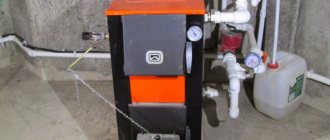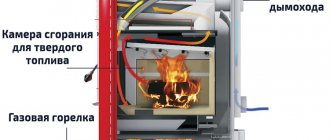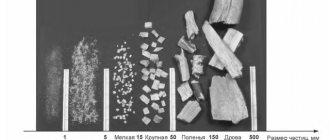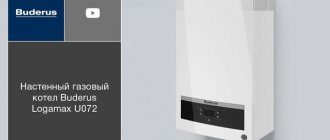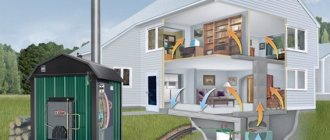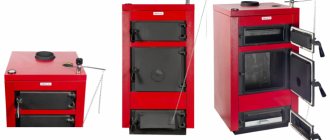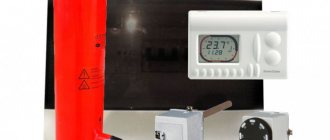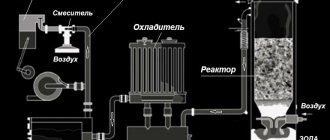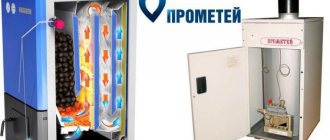Liquid fuel boilers make it possible to make the heating of the house completely autonomous from the central gas pipeline. They are used for both space heating and water heating. There are many models, so before buying, you need to understand the specifics of their installation and operation.
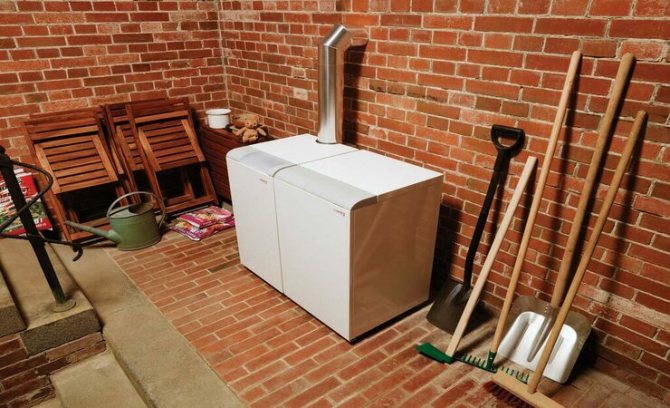
Heat your home with liquid fuel boilers
Equipment advantages and disadvantages
Heating boilers for liquid fuel make the house completely autonomous in terms of heating and hot water supply. They have their pros and cons to be aware of. The main benefits include the following:
- ease of installation;
- ease of operation and maintenance;
- automatic fuel supply;
- no need to obtain a special permit for installation;
- high power and efficiency;
- the ability to use for heating both residential and industrial premises;
- boilers are fully automated.
In this video, we will consider boilers for liquid fuel:
If necessary, the type of fuel can be changed by replacing the nozzle. The devices are characterized by a high level of efficiency. The main disadvantages are as follows:
- noise during operation;
- the need to create a separate room for the boiler and fuel storage;
- availability of uninterrupted power supply;
- the need to install a chimney.
More details: do-it-yourself chimney.
The cost of liquid fuel is quite high. Despite all the shortcomings, such boilers are in demand.
Fuel burners for oil heating boilers.
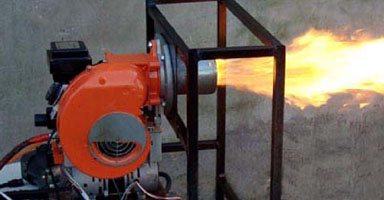

Fuel burners can be specialized (only for burning waste oils - CleanBurn burners), or universal (SmartBurner, OMNI, DanVex burners) with a temperature controller for heating the fuel in the preheater tank, depending on the type of fuel used for combustion (for working with diesel fuel without heating, on vegetable oils heated from 80 to 140 degrees, on waste oils from 70 to 100 degrees).
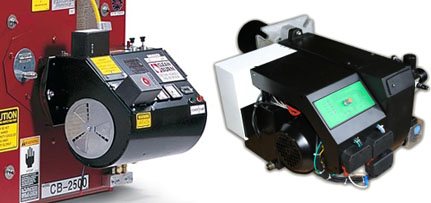

Fig. Fuel burners CleanBurn (left) and DanVex (right).
Some fuel burners are self-contained without a compressor and preheater tank (DanVex), others have a built-in compressor and fuel preheating chamber (SmartBurner, OMNI).
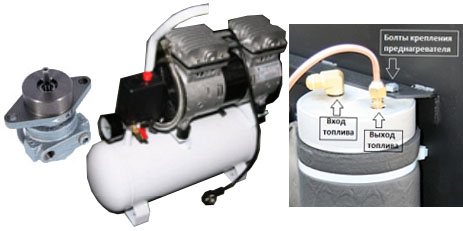

Fig. Integrated OMNI burner compressor (left) and stand-alone compressor and DanVex burner preheater (center and right).
Regardless of the features of the nozzle block and the general design, all fuel burners of oil heating boilers, including waste oil heating boilers, work according to the same principle - from the reserve tank, fuel is supplied to a separate chamber (tank) for heating to the desired temperature, and then sprayed in a mixture with compressed air by a nozzle and ignited by an electric arc arising between electrodes built into the nozzle, which are supplied with high voltage from a transformer.


Fig. Adjustment of the electrodes of the nozzle block of the DanVex fuel burner.
Principle of operation and device
Liquid fuel devices work on the same principle as gas ones. The main difference lies in the use of a nozzle (fan burner). The boiler has the following structural elements:
- common building;
- burner;
- Control block;
- the combustion chamber;
- chimney;
- heat exchanger.
The package also includes a pump that is responsible for supplying fuel to a special tank. To improve efficiency, some manufacturers complete the device with heat exchange plates and chimneys.
The control unit is fully automatic.The body is completely insulated. This increases the efficiency of the device and also minimizes heat loss. The outside of the boiler is covered with a special film, which remains cold even when the unit is heated, so there is no risk of getting burned.
The principle of operation of an oil heating boiler
Liquid fuel enters the fan (inflatable) burner. In the burner, the fuel is mixed with air, after which it is atomized by the fan and ignited in the combustion chamber. The walls of the chamber are heated, and, consequently, the heat carrier in the heat exchanger is also heated.
Combustion gases are discharged through the chimney. When passing up to the chimney, the combustion gases pass through a series of heat exchanger plates, also giving off heat to the heat exchanger. This also increases the efficiency of the boiler.
When liquid fuels are burned, a large amount of soot is formed. This is due to the chemistry of combustion of liquid fuel. Therefore, liquid fuel boilers require increased attention to their maintenance. It is necessary to periodically clean the walls of the combustion chamber from the formed soot. Also, an inflatable burner of an oil boiler requires constant monitoring of its condition.
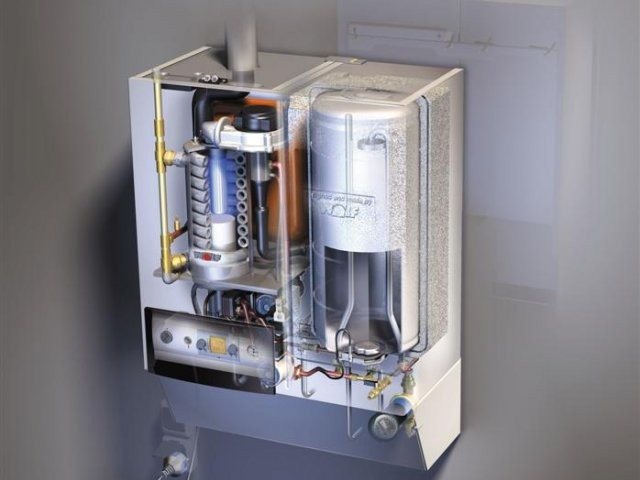

Varieties of boilers
All models can be divided into several groups depending on the principle of operation and the fuel used. There are two principles of fuel combustion:
- Evaporation of liquid fuel occurs from the surface of the bowl. The fuel itself burns slowly, so the volume of vapors is quite large. Most often, this principle of action is found in home-made devices.
- A flare burner is used. The fuel, like in the first method, goes through pyrolysis. However, the mixture is prepared, vaporized and burned directly in the torch flame.
Flare boilers are more versatile. Most often they are used for heating country houses. They can work for:
- fuel oil;
- diesel;
- reduced gas;
- working off.
It is interesting: how to make a waste oil boiler.
Devices that have pre-evaporation cannot burn diesel fuel and gas. Heating units can also be divided into factory and homemade ones. The former are safer and more effective.
Multi-fuel oil fired boiler and waste oil boiler.
Prominent representatives of multi-fuel equipment are cast iron and steel sectional heating boilers for liquid fuel OMNI from EconoHeat, Inc, steel and cast iron boilers for heating oil and natural gas Logano holding BBT Thermotechnik GmbH (Bosch Buderus Thermotechnik) and industrial oil heating boilers Roca commercial group Roca Group with a heat-resistant stainless steel heat exchanger.
The common design of these oil heating boilers is the installation of stainless steel turbulators in the smoke ducts, as well as access for maintenance only through the front door. Differences between boilers in the design of the heat exchanger and the material of the smoke channels - in OMNI oil heating boilers, the smoke channels are profiled in cast iron sections and are located along the perimeter of the combustion chamber, in boilers from other manufacturers the smoke channels are made in the form of heat-resistant stainless steel pipes distributed around the circumference of the chamber combustion evenly or in the upper, upper and side segments.
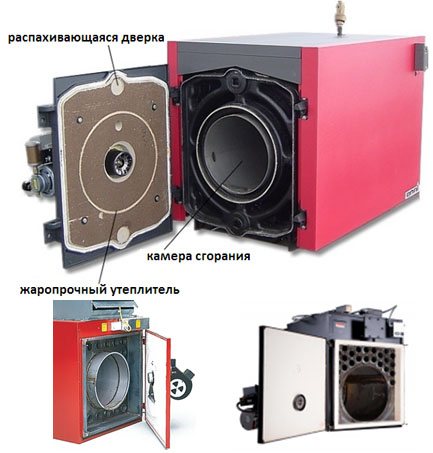

Typical representatives of waste oil heat generators are heating boilers EnergyLogis and predominantly focused on working with liquid fuel heating boilers from DanVex (Finland).


Both types of these oil heating boilers have a three-way movement of combustion gases through the smoke ducts, front and rear opening doors, which make it easier to clean the combustion chamber and smoke tubes, as well as a unified flange in the front door for installing fuel burners from other manufacturers and of our own production, moreover the door opens together with the fuel burner, which makes it convenient to service the nozzle block.
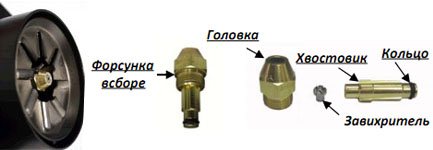

Device selection criteria
Domestic liquid fuel boilers are manufactured by both European and domestic companies.When choosing, you should pay attention to the main characteristics of the device. You need to consider:
- power;
- price;
- functionality;
- availability of additional functions.
The optimal power of the device must be calculated by a specialist. The functionality of the units is manifested in the fact that single-circuit models are aimed only at heating. Double-circuit can not only heat, but also be connected to hot water supply.
Prices for liquid fuel devices are different. German-made models are the most expensive, most of them belong to the premium class. The middle price category is represented by devices from Korea. They are multi-layered and fully automated. The most accessible are models of domestic production.
An important factor when choosing a heater is the manufacturer's brand itself. The most popular products are from the following manufacturers:
- Gecko;
- 5Energy;
- Viessmann;
- De Dietrich;
- Navien;
- Kiturami.
Read more: korean cauldron Kiturami.
The choice of a specific device depends directly on the budget and the wishes of the owner. Domestic models are in no way inferior to European ones. They are not whimsical to raw materials and are equipped with automatic controls.
Additional accessories for oil heating boilers.
Manufacturers of heating boilers for liquid fuel supply, along with their boilers, reserve fuel tanks, often equipped with a fuel cut-off sensor from the tank when the fuel level is below the critical one, a sensor for determining the current fuel level in the tank, a valve for relieving excess pressure in the tank (Fig. Below), and also filters and fuel pumps.


In addition, as an option, you can buy a coil-heat exchanger for heating hot water for household needs built into a heating boiler on liquid fuel, stainless steel chimneys with silencers, filters, pressure gauges and vacuum gauges, as well as maintenance kits, including cleaning the chamber combustion and smoke channels.
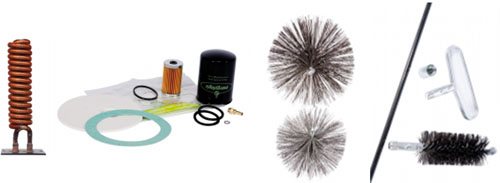

implements in Russia waste oil heating boilers, unique in terms of efficiency during the operational period, allowing to form one of the most economically feasible heating systems at the current time. Waste oil heating boilers from well-known American and European manufacturers are fully adapted to the used oils sold in the Russian fuel market, as well as to Russian operating conditions.
Liquid fuels
The list of types of liquid fuel is quite extensive. The choice of a specific type depends on the boiler model. Most often used:
- fuel oil;
- diesel fuel;
- kerosene;
- waste oil.
It is interesting: selection of a diesel boiler for a private house.
Fuel oil and diesel fuel are fairly light fuels. They are easy to transport and store. Due to the low viscosity of the fuel, it burns as efficiently as possible. The minimum amount of ash and sulfur in the composition ensures the safety of equipment and minimizes emissions into the environment.
When choosing a fuel for a liquid fuel boiler, you should pay attention to the viscosity and the amount of sulfur in the composition. The price of a low sulfur product is higher, but its use has advantages:
- economical consumption;
- low costs for maintenance and repair of equipment;
- minimum amount of harmful emissions into the atmosphere.
You cannot save on fuel. Otherwise, you will have to constantly change the injectors, the fuel filter and clean the tanks from sediments.
Oil boilers rating
Currently, the following models are quite popular on the market for liquid fuel heaters:
Liquid fuel boiler KITURAMI (kiturami)
Kiturami Turbo 9U - 30U
The South Korean brand Kiturami STSO produces stainless steel heating devices using special technologies that ensure the manufacture of lightweight and compact boilers.
- Modifications of the Kiturami Turbo 9U - 30U boilers are most often offered on the market, with the help of which it is possible to heat rooms with an area of up to 350 sq. M. with analysis of the coolant up to 20.7 l / min.
- Power - from 10 to 40 kW.
- The price of such devices ranges from 40 to 50 thousand rubles.
Boiler Bisert AOZHV 11.6
The most popular model from this domestic brand is the liquid fuel boiler AOZHV 11.6
- It can be used for heating industrial and residential premises up to 70 sq.m.
- Thermal power from 10.4 to 11.6 kW.
- Waste oil, kerosene, heating oil and diesel fuel can be used as fuel.
- The standard fuel tank has a volume of 15 liters.
- Such a boiler costs about 10 thousand rubles.
Dacon boiler for liquid fuel
Steel solid fuel boiler DAKON DOR F 27
The boilers of this company are popular due to their unpretentiousness to the quality of fuel (diesel fuel, fuel oil).
- This is achieved through the use of a turbulator in the fire tube and expansion of the combustion chamber with a stainless steel sleeve.
- The power of such boilers is usually 17-90 kW.
- Price from 30 to 70 thousand rubles.
Boiler Bizon 30NL / 40NL / 50NL
Bison 50NL
Heating devices of this brand are manufactured by Protherm from Slovakia.
- The power of the Bizon NL boiler models depends on the number of cast iron sections in a two-pass heat exchanger. The boilers of this line can be operated with both a liquid fuel burner and a gas burner.
- The device has a minimum of sensors and instrumentation.
- For additional money, an optional boiler with a volume of 500 liters is offered with boilers.
- The price of devices is from 50 to 70 thousand rubles.
We also recommend reading:
Features of operation
In order for liquid fuel heating boilers to work efficiently and properly, it is necessary to adhere to the basic recommendations for operation. It is necessary to constantly monitor the amount of fuel in the boiler.
Technical inspection and maintenance of the device is carried out periodically. It is recommended to carry out cleaning and detailed inspection for damage at least 2 times a year. The first inspection is carried out before the start of the heating season, and the second immediately after its end.
An important nuance is the use of only high-quality fuel and the installation of a special filter to clean it. Periodically, it is necessary to check the integrity of the containers in which liquid fuel is stored.
Long burning liquid fuel boilers, if properly operated, can serve for a long period. It is important to carry out technical inspection and troubleshoot on time. Only in this case the operation of the device will be not only efficient, but also safe.
Boiler installation
To install a household liquid fuel boiler, it is necessary to develop a project for the heating system as a whole, which will take into account not only the installation of the boiler itself, but also the arrangement of all the necessary infrastructure:
- A room equipped with an exhaust hood and a chimney.
- Safe placement of the optimal fuel container (larger container minimizes the hassle of filling it).
- Placement of a supply pump that transports fuel to the boiler from the tank.
- Fuel piping arrangement.
If the boiler will be used not only for heating, but also for hot water supply, then a double-circuit boiler will need to be installed. Industrial boilers for liquid fuels, as a rule, are not hot water boilers, but steam. To remove condensate from them, they are equipped with a purge system, and to increase efficiency with an economizer.
For large rooms, boiler equipment is installed.In order for an autonomous heating system based on liquid fuel boilers to work smoothly and correctly, it is better to contact specialized companies for its design and installation.
